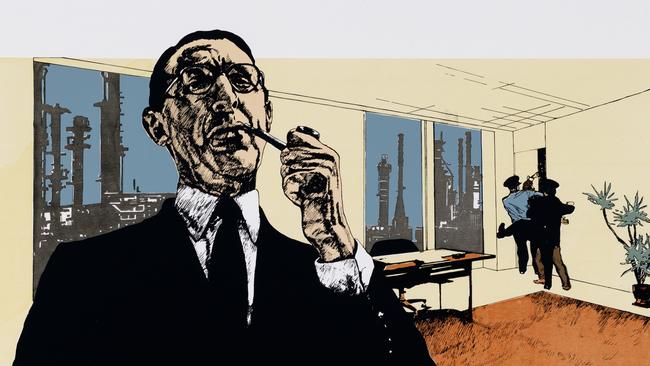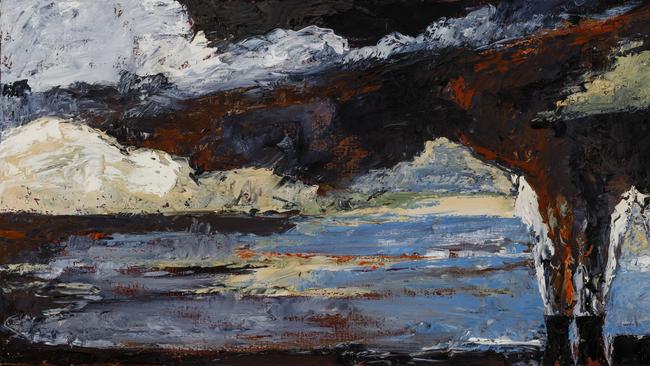Mandy Martin retrospective at Geelong Gallery
A retrospective of Mandy Martin’s work in Geelong is striking in more ways than one.

It is an important part of the mission of public galleries to survey the work of individual artists and movements, both from relatively recent times and from historical periods. And unlike the mid-career survey exhibitions that are too often promotional exercises to support the careers of institutional favourites – a recent example at the Art Gallery of NSW coincided with a commercial show of the same individual’s work – it is particularly useful to look at the whole career and development of artists after their death.
With the most prominent figures, such Sidney Nolan, Russell Drysdale or Jeffrey Smart, there is room not only for comprehensive monographic exhibitions but, as we have seen in the last couple of years, smaller shows that focus on sections or periods of their careers. With a lesser one like Mandy Martin (1952-2021), it is more a matter of rescuing an oeuvre from what Percy Grainger called “forgottenness” and evaluating its ultimate merit.
Retrospectives can sometimes delight us with the richness and diversity they reveal to us for the first time. But they can also reveal fundamental limitations, something that first struck me many years ago in reviewing a retrospective of Godfrey Miller. Encountering his pictures here and there in group shows, I had been intrigued by his quirky and refined vision; seeing them all together in the retrospective revealed the limitation of his imagination and process.
The retrospective of Martin’s work at Geelong is striking in a couple of ways. The most obvious is the contrast between her early poster-like work and the later paintings which have no organic connection to the earlier part of her career. The other thing that is surprising, although only to those who pay attention to the dates of the works, is how little belongs to the last few decades.
The early work takes the form of screen-prints designed ostensibly as political posters, although all but one seem to be produced in limited editions, like any other fine art print. The first set belongs to the years 1974-77, and is marked by generally left-wing, anti-war and feminist themes. The images themselves – collaged from photographic sources – are more interesting as designs than thematically coherent, like one that shows some presumably Vietcong women walking through rice paddies carrying machine guns with babies strapped to their backs. In the middle distance is a monument in the shape of a Coca-Cola bottle.
Apart from the implicit acceptance of the communist invaders of South Vietnam as the good guys, one has to wonder about the curious title of this image: “The drive of the US is to replace traditional status values of the village such as writing great poetry with new ones like owing a TV set”. We can all deplore so-called “Coca-colonisation” which has swept over the world in the almost half-century since this work was produced, but was “writing great poetry” ever a marker of status in a Vietnamese village? And of course if anyone had asserted, at the same period, that ordinary Australians would be better off writing great poetry than owning a television set, he would have been condemned as an elitist snob.

Which brings us, as so often, to the intended audience and market for this kind of work. It is of course middle-class people who sympathise with its ethos or who want to show off their alignment with progressive causes – the precursors of the virtue-signallers of today. At the most alienated level, it can be collectors who like to be associated with what they consider “edgy” or “challenging” work, without the slightest interest in its content, like the wife of a diamond miner who many years ago assured me she loved political art.
One can ask the same sort of questions about the second series of prints, from 1977 onwards, in which Martin redrew the imagery she derived from photographic sources, and was thus able to combine them with greater freedom. This series is dominated by caricatures of the capitalist as an overbearing male figure, usually with a cigar or a pipe, as in two versions of Unknown industrial prisoner (1977) – in both of which the smoking capitalist occupies the left side of the composition, while on the right police or security guards seem to be arresting a hapless worker for unexplained reasons. Once again, looking back on the 1970s in Australia, there were undoubtedly instances of abuse and corruption, but what these images ultimately suggest about our society is ludicrous when we remember that the genocide of the Khmer Rouge was taking place at exactly the same time; that the horrors of the Cultural Revolution in China had only ended with the death of Mao the previous year; and that in almost any country outside the Western world political oppression and illegitimate governments were the norm.
In hindsight, this is like an early manifestation of the narcissistic self-loathing that grips many who think of themselves as “left” today, and leads them to inveigh against the West and the supposedly monstrous crimes of colonisation, when in reality the very ideas of political freedom, freedom of expression, democracy, universal rights – and notably the rights of women – are unique achievements of the West, exported today with greater or lesser success to the whole world.
From 1978 to 2003, Martin taught at the Canberra School of Art, initially in printmaking. Her subject matter changed and became less explicitly political, although a series of works made in the 1980s takes old, apparently abandoned industrial buildings as their subject. Of these, one of the most satisfying works in the exhibition is a black and white screen print of a pathway between two rows of sawtooth roofs, characteristically silhouetted against the sky.
This work is successful because of its contrasting use of perspective and flat pattern, its simplicity and also its small scale. In contrast, the same motif is much less effective when used on a larger, even colossal, scale in a number of oil paintings, the biggest of which is Factory 2 (Sawtooth), from 1981. Here a single row of sawtooth buildings extends into the distance along the side of a road. But a picture on this scale takes itself very seriously, imposes itself overbearingly on the viewer, dominates a whole wall and inevitably falls flat if it does not repay the attention that it demands.
In this and other industrial images, like the similarly colossal Yellow clouds 2 (1983), the scale is grandiloquent but the pictorial and thematic interest are lacking: that is to say, the compositions are simplistic and unsophisticated, and the motifs themselves are not treated with any kind of complexity; mere size is like mere volume and does not equate to resonance. One only has to think for a moment about how similar motifs could be treated by painters like Jeffrey Smart or Rick Amor or even Peter Booth.
A later example is Yallourn Powerstation 7 (1991), a view of several chimneys belching their toxic clouds of smoke into a poisoned atmosphere. Yes, the underlying phenomenon is horrible, but what does Martin’s picture contribute to our understanding of or imaginative insight into this reality? Think in contrast of Philip James de Loutherbourg’s famous Coalbrookdale by night (1801): this image of a blast furnace from the early Industrial Revolution is at once a vision of a horror and tinged with the fascination of the sublime.
The ambiguity and tension that make Loutherbourg’s painting memorable are completely lacking in Martin’s paintings. But there is another problem: her handling of oil painting is clumsy and without any refinement or subtlety. This is part of the problem with the vast perspective of sawtooth factories: the paint application is brutal and yet inexpressive. Nowhere is there a hint of the delicacy and complexity that make us want to look at a picture, and which can transform even the most banal objects and imbue them with poetry.
This clumsiness in the handling of paint is even more striking in the power station picture. It looks like the work of an autodidact who has never actually been taught anything about the technique of oil painting and its pictorial and expressive range as an instrument for picturing the world; this failure of teaching evidently reflects both the circumstances of Martin’s studies and of her own teaching.
Martin’s style is heavy-handed to say the least, and this is what also spoils her landscape pictures. Once again, the best of these are the smallest works, a series of etchings from sketchbook pages, made in 1988. But when she attempts the same subjects – broad views of industrial or mining sites or bays – they feel empty and under-painted. Nowhere is the paint surface interesting, mysterious or suggestive.
At the same time, although these works are meant to be about the destruction of nature, they show very little evidence of any close attention to, or feeling for, nature. It is though she recognised intellectually that the destruction of nature was a bad thing, but had no intimate feeling for the living environment. This strange lack of authentic connection is most acutely felt in the vast pictures which implicitly claim to be making some kind of statement on an epic level.
Among the latest works in the exhibition is the enormous Depaysement (2003) which includes an inscription suggesting that our fear of the wilderness within ourselves is the source of our fear of the wilderness around us. Apart from the fact that it is not clear whether we really are afraid of wilderness, the painting captures little of the grandeur and vitality of a wild environment. Instead it is broadly and loosely daubed in ochre monochromes and then superficially animated with daubs and scratches that are unrelated to the underlying natural forms and therefore distract from, rather that conveying the life of the scene.
The lesson to be drawn from Mandy Martin’s example is that two kinds of humility are preconditions for making good art. The first is the humility to submit to the deep apprenticeship of your instrument, just as a musician has to work selflessly for years to master the violin, the piano or the guitar. Unless you have learnt to use your instrument with fluency, skill and subtlety, it is unlikely that anything you play – or paint – will be worth the audience’s attention.
The other kind of humility is in looking at the world. Even to paint industrial sites demands selfless attention. To paint nature demands even greater devotion, patience and care; it requires the meticulous study of light and atmosphere, of geology and flora, and even more importantly attunement to the intangible life that we sense in the living environment. Without these qualities, painting on a larger scale simply makes the emptiness of the work more apparent. Good art does not arise from speaking in a loud voice but from listening.
Mary Martin – A Persistent Vision
Geelong Gallery, until February 5.




To join the conversation, please log in. Don't have an account? Register
Join the conversation, you are commenting as Logout